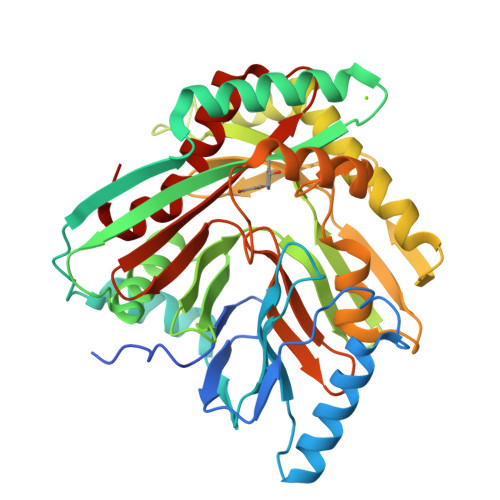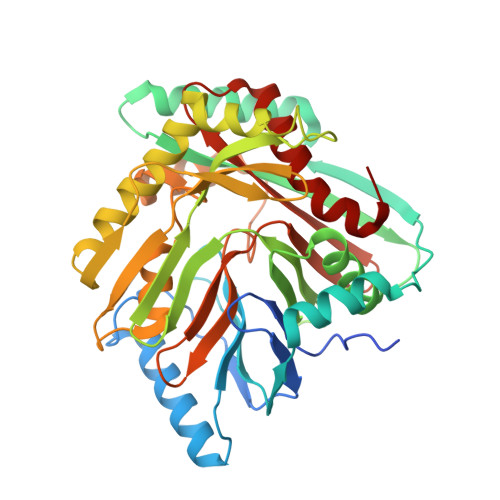Crystal Structure of Escherichia coli Enterobactin-specific Isochorismate Synthase (EntC) Bound to its Reaction Product Isochorismate: Implications for the Enzyme Mechanism and Differential Activity of Chorismate-utilizing Enzymes
Sridharan, S., Howard, N., Kerbarh, O., Blaszczyk, M., Abell, C., Blundell, T.L.(2010) J Mol Biol 397: 290-300
- PubMed: 20079748
- DOI: https://doi.org/10.1016/j.jmb.2010.01.019
- Primary Citation of Related Structures:
3HWO - PubMed Abstract:
EntC, one of two isochorismate synthases in Escherichia coli, is specific to the biosynthesis of the siderophore enterobactin. Here, we report the crystal structure of EntC in complex with isochorismate and Mg(2+)at 2.3 A resolution, the first structure of a chorismate-utilizing enzyme with a non-aromatic reaction product. EntC exhibits a complex alpha+beta fold like the other chorismate-utilizing enzymes, such as salicylate synthase and anthranilate synthase. Comparison of active site structures allowed the identification of several residues, not discussed previously, that might be important for the isochorismate activity of the EntC. Although EntC, MenF and Irp9 all convert chorismate to isochorismate, only Irp9 subsequently exhibits isochorismate pyruvate lyase activity resulting in the formation of salicylate and pyruvate as the reaction products. With a view to understanding the roles of these amino acid residues in the conversion of chorismate to isochorismate and to obtaining clues about the pyruvate lyase activity of Irp9, several mutants of EntC were generated in which the selected residues in EntC were substituted for those of Irp9: these included A303T, L304A, F327Y, I346L and F359Q mutations. Biochemical analysis of these mutants indicated that the side chain of A303 in EntC may be crucial in the orientation of the carbonyl to allow formation of a hydrogen bond with isochorismate. Some mutations, such as L304A and F359Q, give rise to a loss of catalytic activity, whereas others, such as F327Y and I346L, show that subtle changes in the otherwise closely similar active sites influence activity. We did not find a combination of these residues that conferred pyruvate lyase activity.
Organizational Affiliation:
Department of Biochemistry, University of Cambridge, 80 Tennis Court Road, Cambridge CB2 1GA, UK.



















